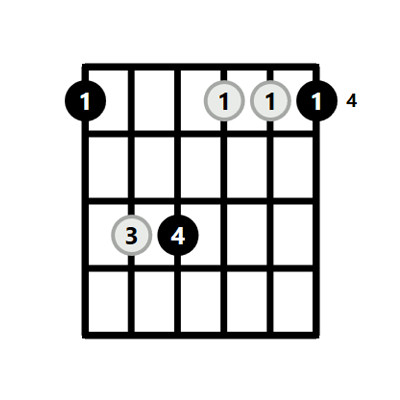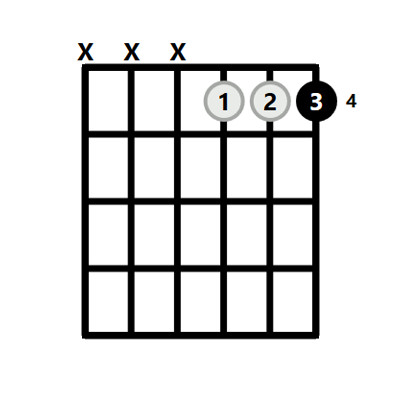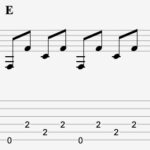The G Sharp Minor Guitar chord (often written as G#m) is a versatile and emotionally rich chord found in many popular songs across genres. While it might seem challenging at first, understanding its construction and exploring different ways to play it will unlock new musical possibilities on the guitar. This comprehensive guide will take you through everything you need to know about the G#m chord, from basic theory to various shapes and practical applications.
Understanding the G Sharp Minor Chord: Theory and Construction
To truly master any chord, it’s beneficial to understand the theory behind it. The G sharp minor chord, like all minor chords, has a characteristic melancholic or sad sound. This tonality comes from its specific intervallic structure.
- Notes in a G#m Chord: The G sharp minor chord is built from three notes: G#, B, and D#.
- Intervals: These notes are derived from the G# minor scale and correspond to the 1st (root), flat 3rd, and 5th degrees of that scale. Specifically, the intervals from the root (G#) are a minor third (to B) and a major third (from B to D#). This combination of intervals – root, minor third, and perfect fifth – is what defines a minor chord.
- Relative Major and Keys: G# minor is the relative minor of B Major. This means they share the same key signature (5 sharps). You’ll also frequently encounter the G#m chord in the key of E Major, where it functions as the iii chord (the third chord in the key).
Understanding these theoretical elements provides a solid foundation for learning and using the G#m chord effectively in your playing.
Exploring Different G Sharp Minor Chord Shapes
One of the great things about guitar is that there are often multiple ways to play the same chord. The G#m chord is no exception. Here are some essential shapes to learn:
1. Standard G#m Barre Chord (Root 6 Barre)
This is the most common and versatile way to play G#m. It’s a barre chord shape rooted on the 6th string.
 G Sharp Minor Chord Guitar
G Sharp Minor Chord Guitar
How to Play the Standard G#m Barre Chord:
- Barre: Place your index finger across all six strings at the 4th fret. Ensure you are applying enough pressure for a clean sound from all strings.
- Middle Finger: Place your middle finger on the 5th fret of the 2nd string (B string).
- Ring Finger: Place your ring finger on the 6th fret of the 5th string (A string).
- Pinky Finger: Place your pinky finger on the 6th fret of the 4th string (D string).
- Strum: Strum all six strings.
This barre chord shape is movable, meaning you can play other minor chords by simply shifting this shape up or down the fretboard.
2. Easy or Mini G#m Chord Shape
For beginners, or when you need a quicker change, the “easy” G#m is a great option. It’s a smaller shape focusing on the higher strings.
 Easy G Sharp Minor Chord Guitar
Easy G Sharp Minor Chord Guitar
How to Play the Easy G#m Chord:
- Index Finger: Place your index finger on the 4th fret of the 1st string (high E string).
- Middle Finger: Place your middle finger on the 4th fret of the 2nd string (B string).
- Ring Finger: Place your ring finger on the 4th fret of the 3rd string (G string).
- Strum: Strum the top three or four strings (from the G string upwards). Avoid strumming the lower strings for this voicing.
This shape is easier to fret and is perfect for situations where you don’t need the full, resonant sound of the barre chord.
3. G#m Barre Chord (Root 5 Barre)
Another barre chord variation uses the root on the 5th string. This shape is less common for G#m itself because it positions the chord higher up the neck, but it’s useful to know as a movable shape for other minor chords. To play G#m in this form, you would start the root 5 minor barre chord shape at the 11th fret.
 G Sharp Minor Barre Chord
G Sharp Minor Barre Chord
While the image is labeled generally, to play G#m root 5 barre, you would adapt this shape starting at the 11th fret, barring with your index finger and adapting finger positions accordingly based on the minor barre chord pattern.
4. G#m Triad Shapes
Triads are three-note chords and are excellent for understanding chord voicings and creating interesting textures. The G#m triad consists of G#, B, and D#. Here are the three inversions and their note orders:
- Root Position: G# – B – D#
- 1st Inversion: B – D# – G#
- 2nd Inversion: D# – G# – B
 G Sharp Minor Triad
G Sharp Minor Triad
By exploring these triad shapes across different string sets, you can develop a deeper understanding of the G#m chord and its sonic possibilities.
5. Alternative G#m Chord Shapes
Beyond the common shapes, there are other ways to voice the G#m chord up and down the fretboard, offering different tonal colors and ease of transition in certain musical contexts. Experiment with finding G#m shapes in higher positions on the neck for unique sounds.
The Musical Context of G#m: Keys, Progressions, and Substitutions
Understanding where the G#m chord fits musically enhances your ability to use it effectively.
Keys Containing G#m:
The G#m chord naturally occurs in several keys:
- G# Minor: As the tonic chord (i chord), G#m is the home chord and the foundation of the G# minor key.
- C# Minor: G#m is the dominant minor chord (v chord) in C# minor, creating a strong pull back to the tonic C#m.
- D# Minor: G#m acts as the subdominant minor chord (iv chord) in D# minor.
- B Major: G#m is the vi chord (minor 6th) in B Major, providing a common minor chord within a major key context.
- E Major: G#m functions as the iii chord (minor 3rd) in E Major, adding harmonic interest.
- F# Major: G#m is the ii chord (minor 2nd) in F# Major.
Common Chord Progressions:
G#m is frequently used in progressions like:
- i-iv-v in G# minor: G#m – C#m – D# (or D#7)
- vi-ii-V-i in B Major: G#m – C#m – F#7 – B
- iii-vi-ii-V-I in E Major: G#m – C#m – F#m – B7 – E
Chord Substitutions:
To add variety and color, you can substitute G#m with related chords:
- G#m7, G#m9, G#m6: These extended minor chords add harmonic richness while maintaining the minor quality.
- B Major Family Chords: Since B Major is the relative major, chords like B6, Bmaj7, or Bmaj9 can sometimes substitute G#m, especially in progressions where a shift in mood is desired.
Scales to Play Over the G# Minor Chord
For soloing or melody creation over a G#m chord, consider these scales:
- G# Natural Minor Scale (G# Aeolian): The most natural choice, providing a classic minor sound.
- G# Harmonic Minor Scale: Adds a raised 7th degree, creating a stronger pull to the tonic and a more exotic sound.
- G# Melodic Minor Scale: Different ascending and descending forms, useful for melodic phrasing.
Further Exploration:
- G# natural minor scale
- G# harmonic minor scale
- How minor chords work
- Chords page
- G# minor arpeggio
- G#m7 chord
- G#m/B chord
- G#m/D# chord
 Get Guitar Chords Galore eBook
Get Guitar Chords Galore eBook
By exploring these scales and substitutions, you can expand your improvisational and songwriting possibilities when using the G#m chord. Practice these shapes and theoretical concepts to fully integrate the G sharp minor chord into your guitar playing.

